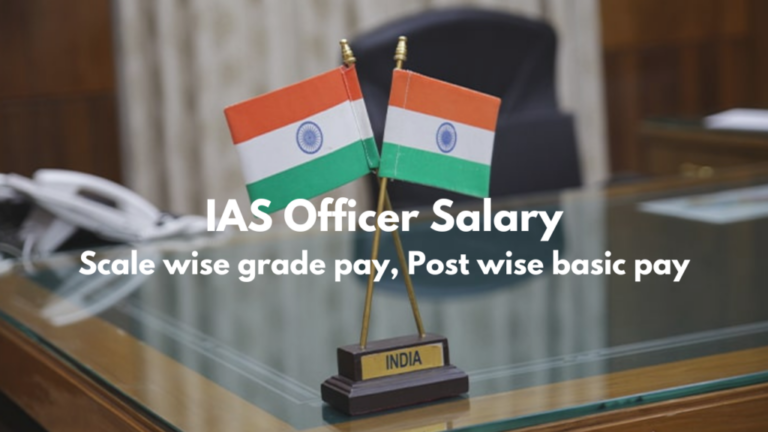What's in the Article: IAS Salary, IAS Salary Per Month, Salary before & After 7th Pay commission, IAS Salary in India, IAS Salary after 5, 10, & 20 years, Post wise IAS Salary
IAS Salary Overview
In 2014, an IAS Officer’s monthly salary ranges from the starting pay of INR 56,100 to INR 2,50,000 for the cabinet Secretary. Besides the basic pay, IAS officer receive various allowances including Dearness Allowance (DA), House Rent Allowance (HRA), Travel Allowance & Other facilities like helper, security guard, vehicle etc. These benefits enhance their overall salary package, reflecting the critical nature of their service to the nation.
The Indian Administrative Service (IAS) stands as the backbone of India’s administrative machinery, attracting individuals with its blend of prestige, power, and responsibility. for many aspirants, understanding the financial aspects, including salary, allowances and other benefits, is crucial in making an informed career decision. This article delves into IAS officer Salary, growth prospects and the additional perks that accompany this esteemed position.
IAS Officers Salary Per Month
The starting salary of an IAS officer after clearing the UPSC exam is approximately INR 56,100, and it increases with years of service and promotions. The maximum salary can go up to 2,50,000 per month for cabinet secretary. Apart from basic pay, IAs officers receive other benefits such as HRA, TA etc.
| IAS Salary in India( According to the latest notification-2024) | |
| IAS Starting Salary | ₹ 56,100/- |
| IAS salary during training period | ₹ 33,000- 36,000 (Depending upon deduction) |
| IAS salary per month | Minimum ₹ 56,100/- to ₹ 2,50,000/- Maximum |
| IAS salary after 5 years | ₹ 67,700 |
| IAS salary after 10 years | ₹ 78,800 |
| IAS salary after 20 years | ₹ 1,44,200 |
| IAS highest salary | ₹ 2,50,500 /- (As Cabinet Secretary) |
| Minimum salary of an IAS Officer | ₹ 56,100/- ( during probation) |
| Perks of IAS | DA, HRA/Residence, Telephone allowance, Security, Study leave, Free Electricity bills, Basic pay, House hold staff, Office Vehicle, Transport Allowance, Job security, lifetime pension, Abroad study option, service quarter, Medical expenses etc. |
Post Wise IAS officers Salary Per Month
Below I have organized the salary of IAS officers post-wise and according to years of service
| Level in Service | Basic Pay (INR) | Post in District Administration | Post in State Secretariat | Post in Central Secretariat | Years of Service |
| Entry-Level | 56,100 | Sub-Divisional Magistrate | Undersecretary | Assistant Secretary | 1-4 |
| 67,700 | Additional District Magistrate | Deputy Secretary | Undersecretary | 5-8 | |
| Mid-Career | 78,800 | District Magistrate | Joint Secretary | Deputy Secretary | 9-12 |
| 1,18,500 | District Magistrate | Special Secretary-cum-Director | Director | 13-16 | |
| Senior-Level | 1,44,200 | Divisional Commissioner | Secretary-cum-Commissioner | Joint Secretary | 16-24 |
| 1,82,200 | Divisional Commissioner | Principal Secretary | Additional Secretary | 25-30 | |
| 2,05,400 | No Equivalent Rank | Additional Chief Secretary | No Equivalent Rank | 30-33 | |
| Top-Level | 2,25,000 | No Equivalent Rank | Chief Secretary | Secretary | 34-36 |
| 2,50,000 | No Equivalent Rank | No Equivalent Rank | Cabinet Secretary of India | 37+ |
IAS Officers Salary Allowance and Other Benefits
- Dearness Allowance (DA): Adjust with inflation, affecting the overall salary package. Currently DA for IAS officer is around 9% of basic pay per month.
- House Rent Allowance (HRA): 8% -24% of basic pay, varying by the city of posting.
- Travel Allowance (TR): For travel expenses, subject to conditions regarding government vehicle provision.
Other Benefits received by IAS officer:
Government provide accommodation, official vehicles, subsidized utility bills, study leave options (including opportunities to study abroad), job security and post retirement benefits.
IAS Officers’ Salary Comparison between 6th and 7th Pay Commission
| Career Stage | 6th Pay Commission Basic Pay (INR) | 7th Pay Commission Basic Pay (INR) |
| Entry Level (Junior Scale) | 15,600 – 39,100 + Grade Pay 5,400 | 56,100 |
| Senior Time Scale | 15,600 – 39,100 + Grade Pay 6,600 | 67,700 |
| Junior Administrative Grade | 15,600 – 39,100 + Grade Pay 7,600 | 78,800 |
| Selection Grade | 37,400 – 67,000 + Grade Pay 8,700 | 1,18,500 |
| Super Time Scale | 37,400 – 67,000 + Grade Pay 10,000 | 1,44,200 |
| Above Super Time Scale | 37,400 – 67,000 + Grade Pay 10,001 | 1,82,200 |
| Apex Time Scale | 80,000 | 2,25,000 |
| Cabinet Secretary of India | 90,000 (Fixed) | 2,50,000 |
Also, read the blogs about How to Appear for the IAS Exam || Study Material for Free IAS Preparation ||Prepare for UPSC Exam Online and UPSC CSE Exam: Eligibility Criteria.
The Overview of the IAS Profession
An IAS officer’s career offers a diverse range of roles and responsibilities, from district administration to policy formulation at the highest levels of government. With each promotion, officers take on greater responsibilities, reflecting in their salary and allowances. To become IAS officer one have to clear UPSC Civil service exam.
The Civil Services Examination of the Union Public Service Commission (UPSC) is considered to be the most prestigious and difficult examination in the country. Lakhs of youths dream of serving the nation by passing the UPSC exam. Only after passing this exam, candidates get posts in the Indian Administrative Service (IAS), Indian Police Service (IPS), Indian Engineering Service (IES) or Indian Foreign Service (IFS) according to their rank. However, among all these posts, most of the discussion is about IAS.
Let’s see all the aspects of the IAS profession
1) How to Become an IAS Officer
The IAS post is available according to the rank obtained in the UPSC Civil Services Examination. Top rankers in this exam get IAS posts, but many times the top rankers choose IPS or IFS, in such a situation even those who get lower ranks get IAS posts. Those with ranks after this get IPS and IFS posts.
2) An IAS Officer Training Process
The 3-month training of IAS takes place at Lal Bahadur Shastri National Academy of Administration (LBSNAA), Mussoorie only. Also known as a foundation course. Here the candidate is given information about every sector of administration, policing and governance. Along with this, some special activities are done inside the academy, which include difficult trekking of the Himalayas for mental and physical strength.
3) What Happens Post-Training
They are sent to their cadre after training. Where they are entrusted with the administration of a particular area or department. They are given executive powers to make proposals and implement government policies for the development of their respective areas as well as take important decisions.
4) How the Cadre is Decided
The most important question after passing the UPAC exam is how to get the cadre. There are a total of 24 services in UPSC, for which candidates are selected. These are divided into two categories, the first one is All India Services. IAS (Indian Administrative Services) and IPS (Indian Police Services) also come in this service. Those who are selected in these are given cadres of states and union territories. Then on the second number are the Central Services which have Group A and Group B services.
5) Posting Process of an IAS
The first posting of an IAS officer is as a Sub Divisional Magistrate. After this, they get promoted to the post of District Magistrate and Deputy Commissioner. IAS officers are needed on the posts of central and state secretariats, who work as PSU heads. Apart from working at the district level, an IAS also works as a Cabinet Secretary as well as Joint Secretary, Deputy Secretary and Under Secretary. This is the highest post in India on which only an IAS officer can be posted. The top post in the state is also that of the Chief Secretary who is an IAS.
6) Responsibilities and Power of IAS Officer
The IAS officer is very powerful as the District Magistrate. An IS has the responsibility of all the departments in the district. As the District Magistrate, he is the head of the police department as well as other departments. The District Magistrate is also responsible for the police system of the district. Only one DM takes all the decisions related to law and order like prohibition, section 144 etc. in the district. DM can also give orders like firing or taking action on the crowd. The IAS officers are controlled by the Department of Personnel and Training and the Ministry of Personnel, Public Grievances and Pensions.
Conclusion
In conclusion, the IAS salary structure offers attractive income potential along with several perks and facilities. The salary package and benefits make the IAS post highly desirable among aspiring civil servants. The government’s focus on increasing the pay structure and facilities further highlights the importance of IAS in the Indian administrative system.
FAQs Related to IAS Salary per Month in India
What is the 1 month salary of IAS?
The 1-month salary of an IAS officer in India may vary depending on various factors such as experience level, posting and allowances. On average, an entry-level IAS officer’s salary can range from ₹56,100 to ₹2,50,000 per month, which includes basic pay, allowances and other benefits. However, it is important to note that this is only an approximate range and the actual salary may vary depending on the specific conditions and government policies.
2) Which is the highest post of the IAS?
The highest rank of the IAS in India is the “Cabinet Secretary“. The position is prestigious and the title is shared among primary ministries. The cabinet secretary is tasked with helping the government manage the significant changes. This post is the biggest and most influential and departmental head is important in all ministries.
3) How many IAS officers are there in India in total?
Can’t give you a definite figure on the number of IAS officers in India. The number of IAS officers may regularly increase as their activities and regulations are considered. As per the government statistics, the number of IAS officers in India may be 6000 or more depending upon the number of jobs and posts. You can check the official websites or IAS association material to get additional information on this data-based assessment.
4) What to become an IAS?
To become an IAS officer in India, one needs to clear the UPSC Civil Services Examination, which consists of a preliminary exam, mains exam and interview. Candidates must have a bachelor’s degree, prepare well for the exam and receive training to develop administrative skills.
5) Which is the most difficult exam in India?
The Civil Service Examination (UPSC CSE) is considered to be one of the toughest examinations in India. It is conducted by the Union Public Service Commission (UPSC) and consists of three phases: preliminary, mains and interview. The vast syllabus, intense competition and comprehensive assessment make it highly challenging.







